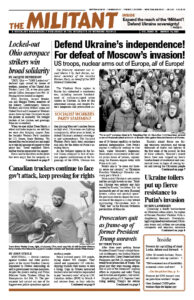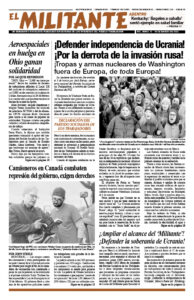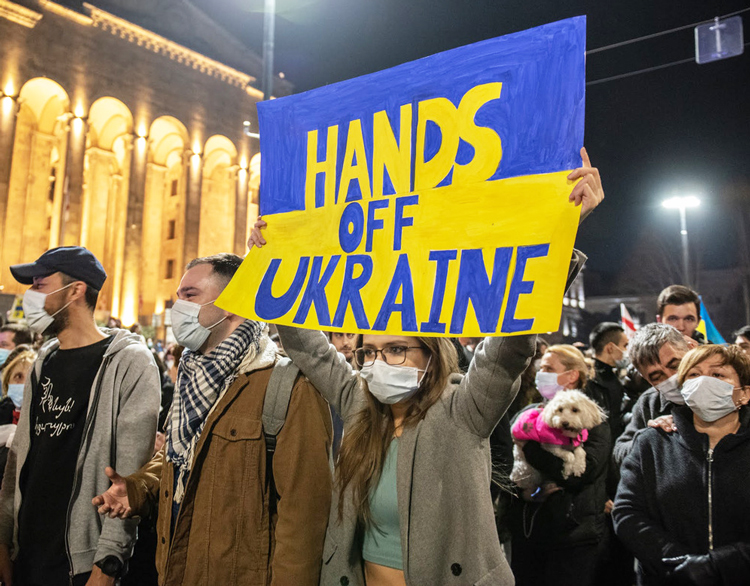Tens of thousands of people worldwide have taken to the streets demanding Moscow get its troops out of Ukraine. This includes protests in Russia and countries like Belarus, where the government provided a platform for the Russian rulers’ assault on Kyiv, Ukraine’s capital. Inspired by the Ukrainian people’s determined defense of their country, protests in some countries have continued day after day.
“No to war!” chanted a crowd of several hundred in St. Petersburg, one of at least 54 Russian cities where demonstrations were held. In Moscow more than 1,000 marched behind a banner, “Ukraine-Peace, Russia-Freedom.”
Close to 200 municipal deputies from Moscow, St. Petersburg and other cities signed an open letter to the citizens of Russia, urging them not to stay silent. “This is an unparalleled atrocity,” the letter said, “for which there is no and cannot be justification.” A letter by 250 journalists and another signed by some 250 scientists denounced the Russian government attack.
As of Feb. 25 some 1,745 people have been arrested there. But thousands continue to protest. “It is a crime both against Ukraine and Russia,” Olga Mikheeva said at a rally in the Siberian city of Irkutsk.
Anti-war rallies occurred in least 12 Belarusian cities Feb. 27. The government responded with a crackdown, arresting over 400 protesters.
Some 30,000 people turned out to protest in Tbilisi, Georgia. Russian troops invaded Georgia in 2008, to reassert Moscow’s dominance. Russian forces still occupy the Georgian territories of Abkhazia and South Ossetia.
On Feb. 27, a crowd of 70,000 gathered in Prague’s Wenceslas Square, the site of 1968 protests against the invasion by Soviet-led troops into what was then Czechoslovakia. Thousands more demonstrated in Budapest Feb. 24, chanting “Russians go home!” a cry heard during the anti-Stalinist 1956 Hungarian Revolution that was crushed in blood by Soviet troops.
Protests in Western Europe
Large demonstrations occurred in cities across Western Europe. A massive crowd of more than 100,000 marched in Berlin Feb. 27
Some 20,000 demonstrated in Bern, Switzerland, thousands in London, and another 1,000 in Manchester, England, Feb. 26. In Athens, Greece, some 3,000 people joined a protest called by Ukrainian organizations.
In the Middle East, a crowd of Iranians, chanting “death to Putin,” defied their government, an ally of Moscow, by protesting outside the Ukrainian Embassy in Tehran. Thousands rallied in Tel Aviv’s HaBima Square Feb. 26. The Israeli government has offered refuge to all Ukrainian Jews fleeing the fighting.
In China, despite a government-orchestrated chorus of support for Moscow, individuals in several cities stood with signs saying, “Chinese stand with Ukraine.”
Protests across the U.S.
Dozens of protests spanned the United States. Demands for Moscow to get out of Ukraine were often coupled with support for U.S. sanctions and NATO military intervention. Socialist Workers Party members joined as many of these actions as possible, using the Militant to point a class-struggle road forward in fighting Moscow’s invasion.
At a rally of 500 in Atlanta, one participant told Sam Manuel, SWP candidate for governor of Georgia, that she wanted NATO to provide air cover to help defend Ukraine.
“The SWP opposes U.S. forces in Europe. This government doesn’t do anything that’s not in the interests of the wealthy in the United States,” Manuel said. “Workers need to organize and rely on ourselves to make any lasting gains. The same is true for the Ukrainian workers and farmers. The SWP opposes sanctions which always fall hardest on working people.”
She wasn’t convinced, but thanked Manuel and the SWP for joining the fight for Ukrainian independence.
In Montreal, where hundreds rallied Feb. 27, members of the Communist League carried signs reading, “Russia out of Ukraine: NATO out of Eastern Europe,” generating discussion and debate among participants.
Most of the middle-class left shunned the protests. Even those that, under the pressure of the massive war moves, opposed Moscow’s invasion, argued that it was the U.S., not Russia’s capitalist rulers, that was responsible for the carnage. “Stop the media warmongering and NATO aggression” was the demand of the Workers World Party.
The Party for Socialism and Liberation went so far as to ignore the entire history of Stalinism, saying, “From 1922 until the dissolution of the Soviet Union, the peoples of Ukraine and Russia lived in peace.” In fact, Stalin and his followers carried out a counterrevolution against Lenin’s policy of self-determination. Countries like Ukraine were oppressed by the czarist rulers. Millions of Ukrainians starved to death in the 1930s under Stalin’s policies.


